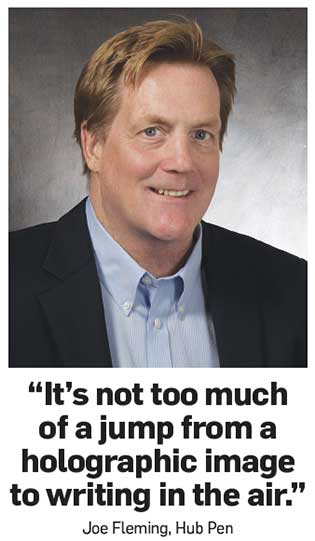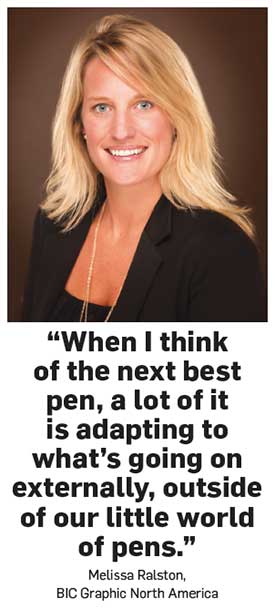Product Hub September 05, 2017
The Future of Writing Instruments
Pens are used every day across countless markets. But where’s the technology heading?
When Melissa Ralston, marketing director at BIC Graphic North America (asi/40480), thinks about her ideal writing instrument, she imagines a multifunction pen with a highlighter and a ballpoint. Luckily for her, that pen already exists – along with an increasing amount of seemingly space-age features on other pens across the market. For example, we can already write in 3-D, with a pen similar to a hot glue gun, that draws objects and words with a piped out plastic medium.
>>Don't Miss! 5 Future Pen Features
“Writing, in many ways, is an experience,” Ralston says. “People all have their favorite types of writing modes; it’s an extension of their preferences and their unique styles.”
As technology improves, consider the places writing instruments could go. Maybe one day, we’ll even have a pen that picks itself up and writes what you said without a single touch of your hand. The possibilities are endless – and some could be here sooner than we think.

Writing Trends
Over the past 10 to 15 years, technology has touched every part of the writing instrument – even down to the ink and what it falls on.
“There’s always a time when you write that the ink sits on top of the paper, no matter how good the ink-tip combination, no matter how good the paper,” says Joe Fleming, president of Hub Pen (asi/61966). “In the last 10 years especially, there have been developments in the chemistries of ink that have made the absorption power of the ink tremendously better, so the ink gets sucked up into the paper really quickly.”
The result? “You can have a really heavy ink lay down without the fear of blobbing or smearing or the left-handed problem of getting ink all over your hand,” Fleming says.
David Goldfarb, product manager for the writing instrument category at Evans Manufacturing (asi/52840), and Ralston both note this is due to special hybrid inks that are in continual development. These inks are a combination of gel and ballpoint ink, so they get the smooth lines of gels and the quick drying time of ballpoints.
“Pens have always been exciting, and the sexy part of the pens has always been the writing quality,” Fleming says. “If you’re writing on paper, the key is going to be the ink-tip combination. I really can’t see pen-to-paper going away any time in the near future. It’s always going to be about the ink-tip combination until we change the substrate of what we’re writing on.”

Writing instruments are also becoming more multifunctional by the day, even without the benefits of so-called “smart” digital pens.
“Pen manufacturers are combining more features in pens including screen cleaners, styluses, flashlights and phone holders,” Goldfarb says. “They are becoming multifunctional tools at an affordable price.”
He notes that some pens even have charging banks for other devices – a development that likely arose with the advent of smart pens that can also digitize what you write, record audio and store files. Smart pens are following their own line of evolution as well. Eventually, suppliers expect they’ll be more universal and able to work with any device, along with incorporating an increasing amount of applications and tools like screen cleaners and USB drives.
Other innovations on the way for writing instruments cover different parts of pens: the barrel and plunger style. “Some of the new features starting to emerge for writing instruments include illuminated imprints, new textures such as soft touch and additions found on the top of plungers, including spinners or cartoon heads,” Goldfarb says.
Ralston sees the same progress, pointing to an increase in the amount of requests for full-color imprints on pens, along with other special options that require research and development.
“We work with our customers, suppliers or engineering to experiment with new decoration techniques, barrel enhancements, ink systems and grip materials,” she says. “Technology has penetrated many industries including the pen industry, so manufacturers are designing pens to keep up with the changes. Every year, as we review our writing instrument product development, we work with our supplier and designers to develop the next best thing.”
In 2017, one of the unique things manufacturers have begun offering is a light-up pen barrel. A logo is laser-engraved onto the barrel of a pen, and when the plunger goes down, it activates a small battery inside that triggers a light, illuminating the logo.
As a testament to how quickly technology changes, Fleming says that eight years ago, Hub Pen tried to create these, but it didn’t work because the batteries were too small and didn’t have enough power to make it a consistently lit-up pen. The company didn’t introduce any at the time. But now, batteries have gotten smaller and last longer so Hub Pen was able to introduce a line, and business for them, Fleming says, is booming. But there’s still a ways to go with the product.
“No matter how good the batteries are, they’re still very small batteries,” Fleming says. “The logo has to look good whether the light’s on or off. That’s where some experimentation is in order, to make sure you have the right substrate and the right paint or lacquer, so when people are unable to activate the light because the battery’s gone out, it still looks good.”
Overall though, the main issue in the evolution of writing instruments, Ralston says, is something the promotional products industry struggles with on a daily basis: the speed at which it adapts to the new technology.
“When I think of the next best pen, a lot of it is adapting to what’s going on externally outside of our little world of pens,” she says. “We need to be prepared to follow the trend of what the next big thing is to make sure we have that application available on our pens. It’s just thinking differently about how we market them and how we can adapt quicker.”
And we should never stop dreaming about what that future writing instrument might be. Technology changes daily, and knowing what to expect is near impossible.
“You look at sci-fi on TV and in books,” Fleming says, following a trip to Hong Kong where he saw an incredibly realistic hologram. “It’s not too much of a jump from a holographic image to writing in the air and transferring information that way so you don’t need a substrate. That would be the next big leap. I can’t see it happening any time soon, but I never expected to see a holographic image that fooled me, either.”
The Persistent Pen
So will pens and writing instruments ever go out of style? Not likely, suppliers say. They’ve been a staple in society for so long that even though people are potentially writing less down, the trusty pen perseveres – plus, according to studies, handwriting improves cognitive development and sparks creativity.
“The writing instrument is over 6,000 years old,” Ralston says. “It will continue to evolve with time, as history has shown us, but never become obsolete. The existence of our recorded history and literature depends on this relationship between paper and pen and we don’t see that ever going away.”

Cavemen first picked up sharpened rocks or pieces of metal or bone as writing tools, carving pictures into cave walls. The ancient Chinese, Babylonians, Sumerians, Greeks and Romans did the same, using pointed objects to carve into everything from turtle shells to wax tablets. But they were faulty, with the carvings fading away after a time.
And so each evolving culture developed their own form of ink, made from organic materials like berries and minerals, alongside the invention of parchment and papyrus. From there came the reed pen, an early form of the quill pen developed around 700 AD. Around the 16th century, in a revelation that would lead to the modern-day pencil, people discovered they could use graphite to write. Metal pen nibs arrived in the 1800s, sparking the invention of fountain pens, the design of which was patented in 1827. The first ballpoints came in 1888, followed by the mechanical pencil in 1906, felt-tip pens in 1910, gel pens in 1984, and now, digital smart pens.
“There’s not a day that goes by that people don’t use pens,” Fleming says. “And it’s going to be like that for the foreseeable future. It’s a low-cost item with daily use. There may be a slight decline, but it’s so ingrained in society that unless something radical happens, you’ll still need pens every day.”
Additionally, writing instruments are just good business. Go anywhere during the day and you’re likely to see a cup full of promotional pens, free for the taking. Look around your desk right now and see how many you have – maybe one from your dentist, the local bank or a tourism company. It’s an easy way for a brand to promote itself, and sales numbers prove it. The category remains one of the five largest in terms of promo product market share.
“Writing instruments continue to be popular, have a strong re-order rate, are inexpensive with a high impression rate, and are appreciated when received,” Goldfarb says. “There is still a big upside to using pens as an advertising tool.”
Fleming agrees, noting that with Hub Pen’s new line of light-up pens, sales are up more than 50% for the group.
“Pens are the new matchbooks,” he says. “They’re everywhere. They’re inexpensive and they’re a good medium for carrying a message. For our industry I think they’re terrific.”
– Email: jennifer@jenniferbillock.com

Product Hub
Find the latest in quality products, must-know trends and fresh ideas for upcoming end-buyer campaigns.
